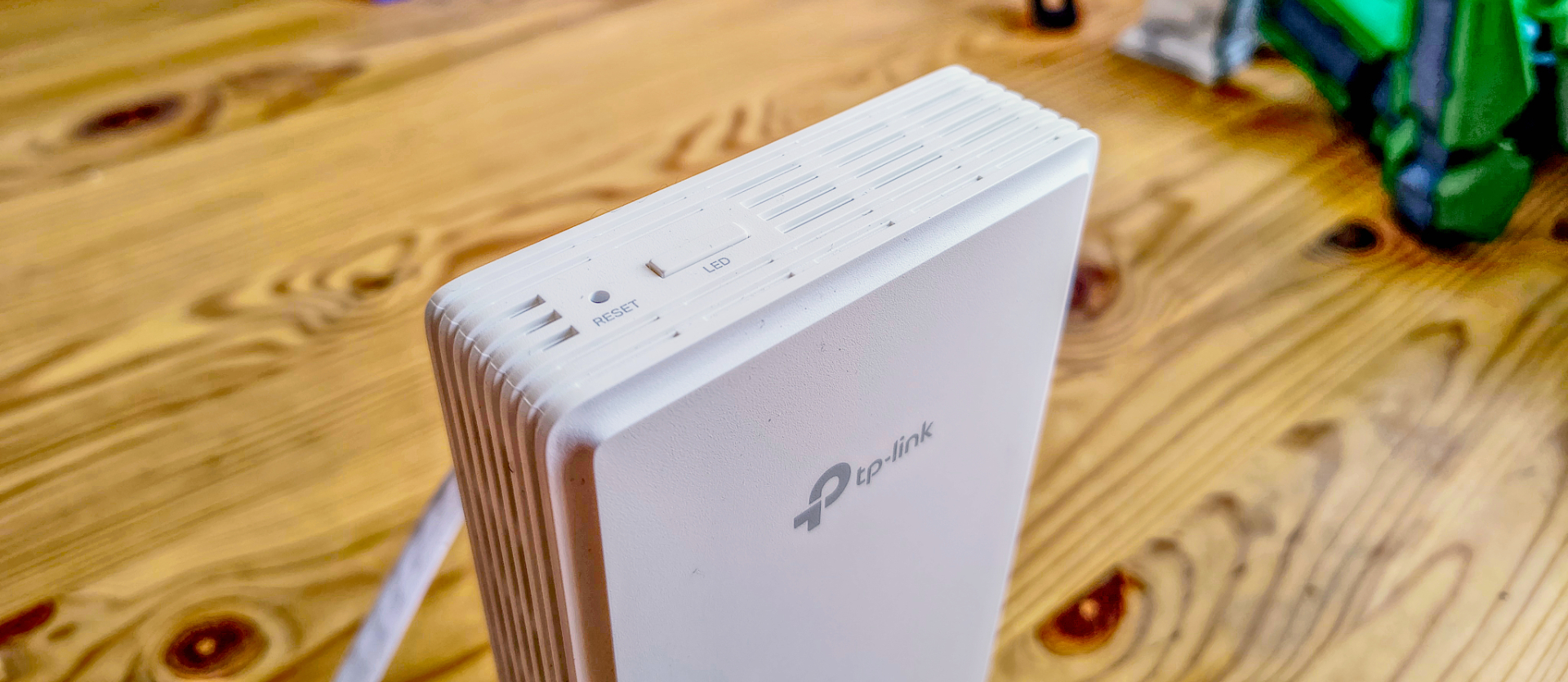Why you can trust TechRadar
We spend hours testing every product or service we review, so you can be sure you’re buying the best. Find out more about how we test.
TP-Link EAP725-Wall: 30-second review
The TP-Link EAP725-Wall is an asset for anyone looking to improve their Wi-Fi setup, particularly for those aiming to boost performance and reliability. As part of TP-Link’s Omada series, the EAP725 provides high-speed connectivity along with advanced features and strong security, making it suitable for both small and large deployments.
This device is designed for specific use cases where the existing LAN infrastructure is leveraged to accommodate both current wired devices and WiFi 7 local equipment. It connects the network through an existing RJ45 Ethernet wall panel and receives power using PoE (power-over-Ethernet).
This allows for easy installation into an existing socket, minimising disruption while adding Wi-Fi capabilities to that specific area of the building. The support for Wi-Fi 7 includes the BE5000 specification in the USA, which offers impressive speeds of up to 4324 Mbps on the 5 GHz band and 688 Mbps on the 2.4 GHz band. However, it is only BE3600 in the EU due to stricter frequency regulations.
Additionally, the device features multiple ports, including a 2.5G PoE input port, a 2.5G pass-through port, and two Gigabit RJ45 downlink ports, facilitating high-speed data transfer and connections for multiple devices.
Integrating the EAP725 into a Wi-Fi strategy can significantly enhance network performance, especially when paired with other TP-Link hardware. The centralised management capability enables network administrators to oversee multiple access points from a single interface, streamlining network maintenance and monitoring.
Furthermore, the mesh networking function allows devices to transition between access points without any decline in connection quality. This device is somewhat niche and has a few caveats that probably exclude it from our best access points round-up.
TP-Link EAP725-Wall: price and availability
- How much does it cost? $135/£129/182 Euro
- When is it out? Available now
- Where can you get it? You can get it through numerous online retailers
What complicates the pricing of this product is that the one sold in the USA has a greater capability than that sold in the UK and EU. Whereas the US version is BE5000 rated, the European model is only BE3600, due to bandwidth restrictions.
Therefore, the $134.82 asking price via Amazon.com can’t be compared to the £128.99 Amazon.co.uk customers will pay, or the €181.20 paid across Europe.
The only competitor product explicitly made for repurposing a wall plate, like the TP-Link EAP725-Wall, is the Ubiquiti Networks Unifi U7 Pro Wall. That sells for £195 in the UK, and $195.95 in the USA, making it marginally more expensive.
However, the U7 Pro Wall is specified to cover an area of 140 m² (1,500 ft²) where the TP-Link hardware is quoted as having a 50 ㎡ (600 ft²) coverage.
However, for those looking to reduce the cost of a multi-room installation and are less concerned about WiFi 7, TP-Link offers three more affordable options. These include the EAP235-Wall, an AC1200 model, the EAP615-Wall, which is an AX1800 option, and the EAP655-Wall, which is AX300 specified. The EAP235-Wall is about $60, increasing to $90 for the EAP615-Wall and $135 for the EAP655-Wall.
Depending on your exact needs, these all do much the same job for less, though they’re probably more suited to a small office deployment than an open office.
TP-Link EAP725-Wall: Specs
|
Feature |
Specification |
|---|---|
|
Model |
TP-Link EAP725 |
|
CPU |
Unknown |
|
RAM |
Unknown |
|
WiFi Bands |
Tri-band WiFi 7: |
| Row 4 – Cell 0 |
– 688 Mbps (2.4GHz) |
| Row 5 – Cell 0 |
– 4324 Mbps (5GHz) in US, 2882 Mbps in EU |
|
WiFi Standard |
IEEE 802.11a/b/g/n/ac/ax/be (Wi-Fi 7) |
|
Ethernet Ports |
1x 2.5G PoE uplink port |
| Row 8 – Cell 0 |
1x 2.5G pass-through port |
| Row 9 – Cell 0 |
2x Gigabit RJ45 downlink ports |
|
USB Port |
N/A |
|
Antennas |
4× Internal Antennas (2x 2.4GHz, 2x5GHz) |
|
Compatibility |
86 mm junction box and EU Standard boxes |
|
Additional Features |
Centralised management, Mesh networking, Seamless roaming, WPA-Personal/Enterprise, WPA2-Personal/Enterprise, WPA3-Personal/Enterprise |
|
Power Input |
802.3at/bt PoE |
|
Power Consumption |
802.3bt: 17W (PoE Out support 15.4W), 802.3at: 17W (PoE Out support 7W) |
|
Dimensions |
143 x 86 x 40 mm |
|
Weight |
365.8g |
TP-Link EAP725-Wall: design
- Compact
- Designed for wall socket deployment
- Combines WiFi and wired
My first head-scratch moment came not long after I removed it from the beige box that TP-Link provided with the TP-Link EAP725-Wall. If you are meant to screw it to an existing wall plate or box, how is that achieved?
Thankfully, the facia is detachable, allowing screws to be inserted from the front, locking it to a suitable socket fixture. There is an assumption made in this design that might not work with older LAN infrastructure, and that’s how the cables that come to a socket are terminated.
If the LAN cable ends in an RJ45 plug, then you are set and can plug that into the back of the AP, and once the other end is connected to a PoE power source or switch, it should become operational.
Older networks used terminal blocks, and in that scenario, you will need to remove the wires from the block and then, probably after cleaning them up, terminate them. Those who did the wiring and thought, “I might need extra wire if something changes”, can pat themselves on the back, and those who didn’t might need to get creative.
One of the key design features of the EAP725 is its support for Wi-Fi 7, which offers high-speed connectivity and improved performance. With speeds of up to 4324 Mbps on the 5 GHz band (US model only) and 688 Mbps on the 2.4 GHz band, the EAP725 ensures that users can enjoy seamless streaming, gaming, and browsing experiences without any lag or interruptions. The tri-band Wi-Fi capability also allows for better distribution of devices across different frequency bands, reducing congestion and improving overall network performance.
The EAP725 is equipped with multiple ports, including a 2.5G PoE input port, a 2.5G pass-through port, and two Gigabit RJ45 downlink ports. This allows for high-speed data transfers and multiple device connections, making it ideal for environments with high data demands. The PoE (Power over Ethernet) support simplifies installation by allowing the device to receive both power and data through a single Ethernet cable, reducing the need for additional wiring.
My only reservation is that they made the PoE pass through the 2.5GbE pathway, and not one of the LAN-only ports. In a perfect world, this wouldn’t be an issue, but it might be if you want a local 2.5GbE LAN connection and also to extend the wireless network with another PoE access point.
Overall, the TP-Link EAP725 is a robust and versatile access point that can significantly enhance a Wi-Fi strategy. Its high-speed connectivity, advanced functions, and security features make it a valuable addition to any network, providing reliable and efficient performance in various deployment scenarios.
If you have standard LAN wall plates and the cables inside them are terminated, then this could be the easiest deployment, ever.
Design score: 4/5
TP-Link EAP725-Wall: In use
- Managed or unmanaged
- Limited EU bandwidth
- Uncomfortably warm
In terms of features, the EAP725 offers advanced functions such as centralised management, mesh networking, and seamless roaming. The Omada centralised management feature allows network administrators to manage multiple access points from a single interface, simplifying network maintenance and monitoring.
Mesh networking ensures that devices can seamlessly roam between access points without experiencing any drop in connection quality, providing a consistent and reliable network experience.
In my testing, I used this hardware managed by a TP-Link Omada OC300 hardware controller. And, for those using this platform, it is an elegant and refined experience.
One curiosity, for those who haven’t, is that when you bring the individual config panel up for an access point, it won’t offer you SSID modification. That’s done on a location basis, and therefore can be rolled out across all APs in a single stroke.
The only minor downside to centralised control of this type is that the individual web interfaces for each AP are disabled once they’re under the control envelope. Therefore, should the controller fail, and you don’t have a spare computer to load a software-only version, then you’d be forced to reset every AP and manually configure it.
The initial setup and configuration might also be complex for users unfamiliar with networking, and the high-end features make the EAP725 more expensive compared to basic access points
This lockout mode demonstrates that security is also a top priority for the EAP725, with features such as WPA3 encryption, rogue AP detection, and support for up to 16 SSIDs. These features ensure a secure network environment, protecting sensitive data from potential threats and allowing for the creation of multiple virtual networks to cater to different user groups or applications.
A significant limitation of the EU version of this device is its 160 MHz bandwidth, compared to the US version’s 240 MHz bandwidth, which essentially doubles the throughput on 5GHz channels. This is due to regional spectrum regulations and interference management policies. The FCC (Federal Communications Commission) in the US allows broader use of the 5GHz and 6GHz bands, including wider channel widths like 160MHz and 240MHz for Wi-Fi 6E and Wi-Fi 7.
In Europe, the ETSI (European Telecommunications Standards Institute) and national regulators impose stricter limits to avoid interference with radar, weather, and military systems. This often restricts usable bandwidth to 140MHz or less, especially in urban areas.
That’s mildly annoying, since the hardware is probably identical; it’s only configured to be aware of the restrictions in the local region. For European IT, this isn’t something they can easily get around, unless they choose to import US hardware and break the law by using it.
However, that isn’t the only potential drawback of the EAP725. The power consumption requirements for the PoE pass-through feature may necessitate an 802.3bt input if the downstream device’s power consumption exceeds 7W. When you consider that it might be powering another PoE device downstream, that’s plenty of power consumption going through this access point.
Even without sending power to a connected device, the TP-Link EAP725-Wall gets hot, and after being operational for 24 hours, it hit 51.3 °C. Much hotter, and it might melt a cheaper plastic wall socket.
Due to this aspect, I’d recommend using the power management feature of this hardware, so it can at least cool down overnight.
TP-Link EAP725-Wall: performance
- Needs Wi-Fi 7 clients
- Range limits
- EU performance reduction
The TP-Link EAP725 is designed to deliver high-speed connectivity and robust performance, making it a valuable addition to various network environments. With support for Wi-Fi 7, the EAP725 offers impressive speeds of up to 4324 Mbps on the 5 GHz band and 688 Mbps on the 2.4 GHz band.
My experience was that at close range, using an HP laptop with the BE201 network adapter, transfers of 1.4Gbps were achievable. But, and this is the flipside of WiFi 7, because the ability to use multiple channels reduces dramatically when the distance is greater or there are physical obstacles (walls) between you and the access point.
Due to the scale of this device and because the antennas are all inside, the fifty square feet coverage is probably an accurate assessment of what to expect.
What it lends itself to is a localised AP in a small office, typically one for middle managers with their assistant outside. Or in a corridor where digital foot traffic is constant.
Because of the relatively short range and the EU’s limited bandwidth, it probably isn’t ideal for a workplace with an open plan.
In summary, the TP-Link EAP725 excels in environments with high data demands and multiple device connections, such as offices, schools, and small commercial spaces. Its high-speed connectivity, advanced functions, and robust performance make it a valuable addition to any network. However, users in the EU and those unfamiliar with networking may face some challenges in achieving optimal performance.
TP-Link EAP725-Wall: Final verdict
For those embracing PoE, the TP-Link EAP725-Wall seems manna from heaven, although it does come with a few caveats.
Those in the EU desperately need the valid WiFi frequencies to be overhauled so they get as much bandwidth as the Americans, and perhaps a design with fin cooling might stop this equipment from getting so hot.
What’s truly wonderful about it is hidden from those who haven’t gone down the TP-Link Omada managed rabbit hole. Once freed from being an ordinary AP, it can provide those administering it with all the ammunition needed to justify a wider deployment or repositioning.
There are probably better wall-plate access points, or at least cheaper ones, but if you have existing Omada gear, then this one is another team player for your wireless network.
Should I buy a TP-Link EAP725-Wall?
|
Attributes |
Notes |
Rating |
|---|---|---|
|
Value |
A reasonable price for WiFi 7 hardware |
4/5 |
|
Design |
Easy to deploy PoE wall or ceiling-mountable. |
4/5 |
|
In Use |
Works with Omada management but it gets hot |
45/5 |
|
Performance |
Limited range and half the bandwidth in the EU |
3.5/5 |
|
Overall |
Handy equipment for enhancing infrastructure |
4/5 |
Buy it if…
Don’t buy it if…
For more connectivity solutions, we’ve reviewed the best business routers
Read the full article here















